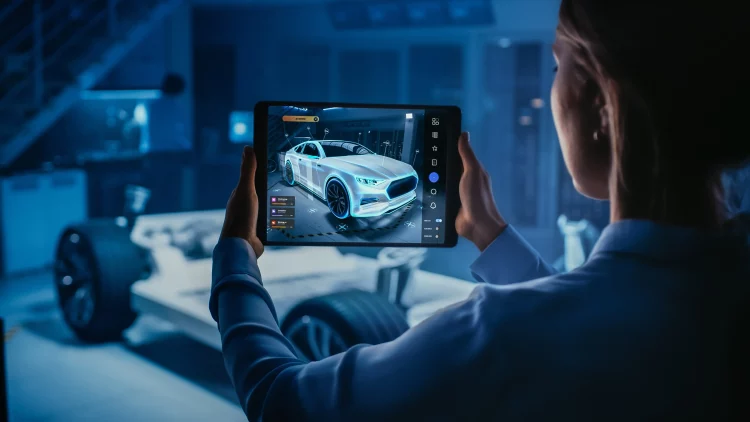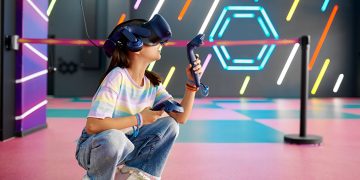I wake up to a gentle chime, not from my phone, but from my AR-enabled alarm system. Light filters through my bedroom windows, augmented with a subtle overlay displaying weather, traffic, and my schedule for the day. My personal assistant, ARia, greets me: “Good morning, Kai. Your morning meeting has been moved to 9:30 AM. The new traffic route adds only seven minutes to your commute.”
I slide on my AR glasses as I get out of bed. The city outside my window is already alive, not just in its physical form, but in the layers of information that hover invisibly over streets, parks, and buildings. Delivery drones navigate through streets with holographic path indicators, while my AR interface highlights the best walking path to the subway, showing air quality, crowded areas, and points of interest. Every step I take feels guided, informed, and connected.
Morning Routine: From Home to Work
Breakfast is augmented too. My smart kitchen displays nutrition information on the countertop: the calorie count of eggs, the protein content of avocado, and a real-time update of my vitamin intake compared with my weekly goal. Even the toaster has a mini interface projecting recommended cooking times and flavor preferences. In this life, AR is invisible yet essential—it silently optimizes my daily decisions.
On my walk to the subway, I notice street vendors using AR to attract customers. Holographic menus float above food carts, offering nutritional info and customer reviews. People stop to scan items with their AR glasses, placing orders with gestures that the devices recognize seamlessly. I, too, am part of this network, choosing my morning coffee based on augmented feedback: barista reviews, bean origin, and freshness indicators—all displayed in my AR overlay.
Subway stations are even more fascinating. AR directions float above the crowded floors, guiding commuters to the least congested entrance. Train arrival times, coupled with occupancy data, allow me to choose a car with more space. I glance at an interactive city map hovering midair, showing subway maintenance alerts, street closures, and even points of interest for later exploration.
Workplace Integration: Augmented Collaboration
At the office, AR transforms meetings into immersive collaborative experiences. My team is distributed globally, yet through AR, it feels like we’re sitting around the same table. Holographic displays allow me to interact with 3D models of products, manipulate graphs in midair, and annotate digital whiteboards that everyone sees in real-time.
I lean over a virtual model of a new product design. By gesturing, I rotate the prototype, inspect internal components, and even simulate stress tests. A colleague in Berlin taps on a component, highlighting a potential flaw. AR allows us to instantly share insight, bridging both distance and cognition. The meeting feels fluid, intuitive, and almost tactile.
Even my own productivity is enhanced. Notes, task lists, and reminders hover subtly at the periphery of my vision. When I glance at a client file, AR highlights key data points, historical interactions, and relevant market trends. Context is delivered precisely when needed, reducing cognitive load and improving decision-making speed.
Lunch and Public Interactions
Lunch is at a small park nearby. I remove my AR glasses momentarily, wanting a break from digital overlays, but even without them, I feel their presence in subtle ways. Other diners wear AR lenses, and interactions are shaped by what is visible in each person’s augmented view. Social cues are sometimes guided by digital indicators: a friend waving, a colleague’s presence indicated through shared location overlays, or a new pop-up suggesting that a food truck I like has arrived nearby.
Service robots work alongside humans. Some are delivering meals to tables, others managing park sanitation, their positions and functions visible in my AR interface for safety awareness. The integration of AR with robotics creates a seamless human-machine ecosystem. The city feels alive, but not chaotic; instead, it is choreographed through layered information.
Afternoon Tasks: Navigation and Exploration
In the afternoon, I venture into a part of the city I rarely explore. AR guides me through unfamiliar streets, showing historical facts, hidden shops, and art installations overlaid on buildings. As I walk, I see virtual signposts that only I can perceive, guiding me to a café recommended by an AR social network.
Retail stores have embraced AR fully. Products are displayed with interactive 3D overlays: shoes show how they would look on my feet, clothing items adjust virtually to my body shape, and kitchen gadgets animate to demonstrate their function. Touch screens are optional; gestures and gaze tracking control most interactions. AR enhances not just convenience, but also engagement and understanding.
I pause near a digital mural projected on a building. Local artists use AR canvases to add layers visible only to those with AR devices. The city becomes a canvas, simultaneously physical and digital, curated by countless creators and viewers. I realize that reality is no longer singular; it’s layered, collaborative, and personalized.

Evening: Entertainment and Social Engagement
Evening brings entertainment. Friends meet in a hybrid AR-physical café. Some are physically present, others join as holograms. We play AR board games projected onto tables, blending tactile and digital interaction. My friend in Tokyo moves a virtual piece, and I see the shadow and reflection as if it were real, synced perfectly with my local environment.
Movies, concerts, and exhibitions are augmented as well. AR can enhance reality with additional information, artistic layers, or interactive elements. Watching a play, I can view character backstories in real-time, or access subtitles in multiple languages without affecting others’ experience. AR personalizes engagement while keeping shared experiences communal.
Night: Reflection and Integration
At home, the day winds down. My AR interface summarizes achievements: steps walked, calories burned, tasks completed, and social interactions recorded. It also suggests tomorrow’s schedule, optimal commuting routes, and energy-saving options for my apartment. I pause, reflecting on the seamless integration of AR into my life.
Augmented reality does not replace human experience—it enhances perception, decision-making, and interaction. By overlaying information onto the physical world, AR allows humans to engage more fully, make informed choices, and explore possibilities previously inaccessible.
Yet there are challenges. Privacy concerns, cognitive overload, and social disparities in access can affect well-being. I must navigate the interface consciously, balancing augmented information with real-world presence. AR shapes life not just technologically, but ethically, socially, and psychologically.
Final Thoughts
AR has transformed ordinary routines into layered experiences. From breakfast to commuting, work to leisure, human perception is extended, enriched, and guided. Reality itself is no longer static; it is interactive, personalized, and intelligent.
Through AR, humans become both explorers and architects of layered worlds, blending physical presence with digital augmentation. Life is richer, more connected, and more informed, yet it demands mindfulness to ensure technology serves humanity rather than distracts it.
As I remove my AR glasses before sleep, the city continues its silent augmentation. Tomorrow, I will wake, navigate, work, and interact within layers of reality unseen by the unaugmented eye. AR has become a partner, a guide, and an extension of human perception—bridging the tangible and the intangible, the real and the digital.












































